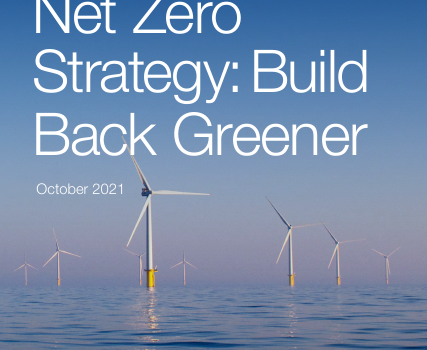
The UK government has set a target to achieve net zero greenhouse gas emissions by 2050, which means that the country will emit no more carbon dioxide and other greenhouse gases than it removes from the atmosphere. Achieving this ambitious target requires a wide range of measures across all sectors of the economy, including energy, transport, industry, agriculture, and buildings.
What is Net Zero in global terms?
Net zero refers to achieving a balance between the amount of greenhouse gas emissions produced and the amount removed from the atmosphere. The goal of net zero is to reduce the overall level of greenhouse gas emissions to limit the increase in global temperatures and mitigate the impacts of climate change.
Achieving net zero involves reducing greenhouse gas emissions through various measures, such as transitioning to renewable energy sources, improving energy efficiency, and implementing carbon capture and storage technologies. Any remaining emissions that cannot be reduced must be offset by removing an equivalent amount of emissions from the atmosphere, such as through reforestation or other forms of carbon sequestration.
The concept of net zero is increasingly being adopted by countries, cities, and businesses as a way to address the urgent need to reduce greenhouse gas emissions and combat climate change. Many countries have set targets to achieve net zero emissions by mid-century or earlier, and there is growing momentum for a global transition to a net-zero economy.
Strategies for getting to Net Zero by 2050
Some of the key strategies that the UK is adopting to reach net zero by 2050 include:
-
Investing in renewable energy sources: The UK government has pledged to increase the proportion of electricity generated from renewable sources to 50% by 2030 and is investing in offshore wind, solar power, and other clean energy technologies. As a result of the war in Ukraine, this push for renewable sources has grown, as the supply of fossil fuels has been cut.
-
Phasing out fossil fuels: The UK is gradually phasing out the use of fossil fuels in power generation, transport, and industry. The government has announced plans to ban the sale of new petrol and diesel cars and vans from 2030 and is investing in public transport infrastructure, cycling, and walking. The UK’s fossil fuel dependency is gradually dropping, however, the dependency was still at 78.3% in 2021, as per Statista. The drop is significant compared to the 96.5% in 1970 but needs to accelerate significantly to achieve the net zero target by 2050.
-
Improving energy efficiency: The UK is taking steps to improve the energy efficiency of buildings, appliances, and industrial processes. The government has introduced regulations requiring all new homes to be built to a high energy efficiency standard and is offering financial incentives to homeowners and businesses to upgrade their properties. Previously, the Green Homes Grant was available to homeowners, however, it was vastly unpopular and ineffective. Much of the funds were redistributed at the end of the scheme, and it was replaced by the ECO4 scheme, which is due to be supported by the ECO Plus scheme.
-
Carbon capture and storage: The UK is investing in carbon capture and storage (CCS) technology, which captures carbon dioxide emissions from power plants and other industrial processes and stores them underground.
-
Tree planting and land use: The UK is increasing tree planting and other land-use measures to absorb atmospheric carbon dioxide. The government has targeted increasing tree planting to 30,000 hectares per year by 2025.

UK power sector emissions over time – https://assets.publishing.service.gov.uk/government/uploads/system/uploads/attachment_data/file/1128689/mission-zero-independent-review.pdf
How is the UK getting on so far?
The seminal resource for the current state of the Net Zero objective is ‘MISSION ZERO, Independent Review of Net Zero’, conducted by Rt Hon Chris Skidmore MP. He makes several conclusions that indicate what has been achieved and where more significant action is required:
- ‘However, the need for further action is clear. For all the UK’s successes and clear ambition shown by government, it is not on track to deliver on all of its commitments according to the latest progress report by the CCC, which shows risks across most sectors – but particularly agriculture, aviation, waste, and buildings decarbonisation.’ MISSION ZERO
- ‘Similarly, we must invest in nature restoration and protection as part of our plans for climate recovery and economic growth. Our economies are embedded within nature,90 and sustained economic growth requires the recovery of nature. A report by the World Economic Forum and PwC found that “$44 trillion of economic value generation – over half the world’s 33 total GDP – is moderately or highly dependent on nature.”91 In particular, the Review sets out a clear call to action to drive progress on nature restoration and nature-based solutions to deliver net zero. When well-implemented in the right places, investment in nature can help us mitigate and adapt to climate change, support the recovery of the natural environment, and provide multiple other benefits to people.’ MISSION ZERO
So what are the benefits for the public?
The drive toward Net Zero is a goal that requires total participation amongst the public. Encouragingly, around 50-60% of the UK is already taking steps to reduce its carbon emissions in some way. If that figure continues to grow in line with increased efforts by the Government, the goal is achievable. As a result, the public can reap significant benefits, including the following:
- Cheaper bills and warmer homes as a result of more use of renewable energy and better-insulated homes. British homes are the least well-insulated homes in Europe, so the focus on insulation, especially external wall insulation is crucial. Up to 35% of heat is lost through walls, therefore insulating external walls is the best policy.
- Jobs will inevitably follow in the form of long-term employment in the industries supporting energy efficiency.
- Access to nature will increase by planting trees and the creating larger green areas. Nature brings benefits to people’s health, especially about lower pollution levels.
- Cleaner air is a direct result of moving away from fossil fuel use and internal combustion engines. Electric vehicles provide a cleaner form of transport, making a material difference in long term health.
- Sustainable travel can also reduce congestion and noise pollution. Electric vehicles, public transport, and cycling can all lead to a healthier, quieter environment.
What if we don’t reach Net Zero?
The major risk of failing to reach Net Zero is the increased impact of climate change. We are increasingly likely to see changes in temperature, rainfall, and sea-level rise.
Temperature – Increased chance of summers like 2018, wherein extra energy is required to power fans and refrigeration.
Rainfall – More rain in the winter and less rain in the summer, resulting in different water management, and potential droughts.
Sea-level rise – Continue to rise under all emission pathways.
Our partners at EWI Store post new technical, practical, and theoretical blogs about external wall insulation every Tuesday! Link below.













No Comments yet! Be the first one.